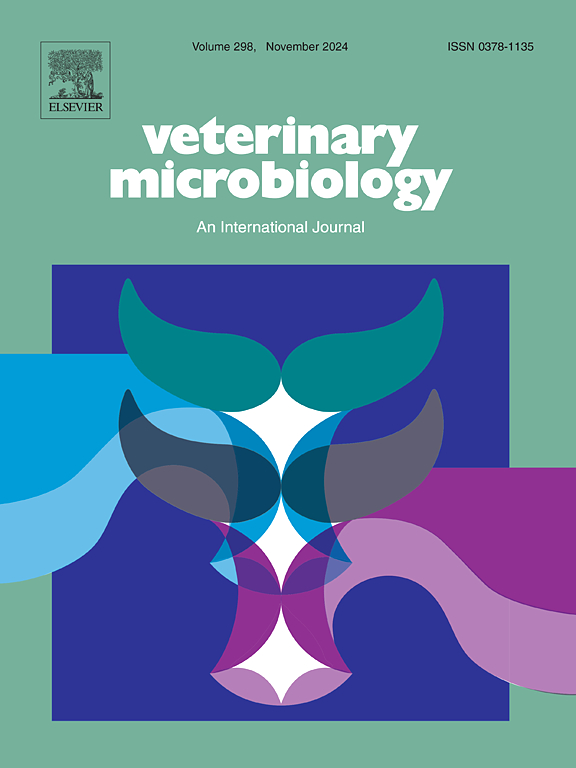Activation of the TLR2/NF-κB signaling axis by capsid proteinVP1 of feline calicivirus promotes IL-1β expression in vitro
IF 2.7
2区 农林科学
Q3 MICROBIOLOGY
引用次数: 0
Abstract
Feline calicivirus (FCV) induces systemic inflammation in felines, posing a serious threat to feline health worldwide. Severe cases may lead to chronic stomatitis and other inflammatory conditions. However, the precise mechanisms underlying FCV-induced inflammation remain unclear. To investigate the involvement of toll-like receptors (TLRs), in vitro experiments assessed changes in TLR gene expression following FCV infection. FCV infection significantly upregulated TLR2 and TLR7 transcription, as well as expression of the NLRP3 gene. Functional assays revealed that inhibition or silencing of TLR2 markedly reduced FCV-induced transcription and secretion of proinflammatory cytokines IL-1β, IL-6, and TNF-α. Conversely, TLR2 overexpression enhanced IL-1β transcription and secretion, further implicating TLR2 in FCV-mediated inflammatory signaling. Mechanistically, FCV infection increased the expression of TLR2 and MyD88, promoted IκBα phosphorylation and degradation, and facilitated NF-κB (p65) phosphorylation and nuclear translocation. Disruption of TLR2 or MyD88 abrogated these events, thereby blocking NF-κB activation and downstream IL-1β expression. Inhibition of any component within the TLR2/MyD88/NF-κB axis—including NF-κB or IκBα—similarly suppressed IL-1β transcription, expression, and secretion, establishing the central role of this pathway in FCV-induced inflammation. Further experiments demonstrated that FCV virus-like particles (VLPs) can induce IL-1β gene transcription through the TLR2/MyD88/NF-κB axis but are insufficient to trigger IL-1β secretion. Dual-luciferase assays confirmed that FCV VP1 alone is capable of activating IL-1β gene transcription via this pathway and directly interacts with TLR2. Collectively, these findings demonstrate that FCV VP1 binds to TLR2, initiates IκBα phosphorylation through MyD88, promotes nuclear translocation of NF-κB (p65), and activates the NF-κB signaling cascade. This cascade primes the inflammasome by inducing transcription of NLRP3, Caspase-1, and IL-1β, as well as expression of the pro-IL-1β precursor, thereby initiating the first signal required for NLRP3 inflammasome activation in FCV-infected cells.
猫杯状病毒衣壳蛋白invp1激活TLR2/NF-κB信号轴可促进IL-1β的体外表达
猫杯状病毒(FCV)在猫科动物中引起全身炎症,对全球猫科动物的健康构成严重威胁。严重者可能导致慢性口炎和其他炎症。然而,fcv诱导炎症的确切机制尚不清楚。为了研究toll样受体(TLRs)的参与,体外实验评估了FCV感染后TLR基因表达的变化。FCV感染显著上调TLR2和TLR7的转录,以及NLRP3基因的表达。功能分析显示,抑制或沉默TLR2可显著降低fcv诱导的转录和促炎细胞因子IL-1β、IL-6和TNF-α的分泌。相反,TLR2过表达可增强IL-1β的转录和分泌,进一步暗示TLR2参与fcv介导的炎症信号传导。机制上,FCV感染增加了TLR2和MyD88的表达,促进了i -κB α磷酸化和降解,促进了NF-κB (p65)磷酸化和核易位。破坏TLR2或MyD88可消除这些事件,从而阻断NF-κB活化和下游IL-1β表达。抑制TLR2/MyD88/NF-κB轴内的任何成分,包括NF-κB或i -κB α,同样会抑制IL-1β的转录、表达和分泌,从而确立了该途径在fcv诱导炎症中的核心作用。进一步的实验表明,FCV病毒样颗粒(VLPs)可以通过TLR2/MyD88/NF-κB轴诱导IL-1β基因转录,但不足以触发IL-1β分泌。双荧光素酶实验证实,FCV VP1能够通过该途径激活IL-1β基因转录,并直接与TLR2相互作用。总之,这些发现表明FCV VP1结合TLR2,通过MyD88启动i -κB α磷酸化,促进NF-κB核易位(p65),并激活NF-κB信号级联。该级联通过诱导NLRP3、Caspase-1和IL-1β的转录以及IL-1β前体的表达来启动炎性小体,从而在fcv感染的细胞中启动NLRP3炎性小体激活所需的第一个信号。
本文章由计算机程序翻译,如有差异,请以英文原文为准。
求助全文
约1分钟内获得全文
求助全文
来源期刊

Veterinary microbiology
农林科学-兽医学
CiteScore
5.90
自引率
6.10%
发文量
221
审稿时长
52 days
期刊介绍:
Veterinary Microbiology is concerned with microbial (bacterial, fungal, viral) diseases of domesticated vertebrate animals (livestock, companion animals, fur-bearing animals, game, poultry, fish) that supply food, other useful products or companionship. In addition, Microbial diseases of wild animals living in captivity, or as members of the feral fauna will also be considered if the infections are of interest because of their interrelation with humans (zoonoses) and/or domestic animals. Studies of antimicrobial resistance are also included, provided that the results represent a substantial advance in knowledge. Authors are strongly encouraged to read - prior to submission - the Editorials (''Scope or cope'' and ''Scope or cope II'') published previously in the journal. The Editors reserve the right to suggest submission to another journal for those papers which they feel would be more appropriate for consideration by that journal.
Original research papers of high quality and novelty on aspects of control, host response, molecular biology, pathogenesis, prevention, and treatment of microbial diseases of animals are published. Papers dealing primarily with immunology, epidemiology, molecular biology and antiviral or microbial agents will only be considered if they demonstrate a clear impact on a disease. Papers focusing solely on diagnostic techniques (such as another PCR protocol or ELISA) will not be published - focus should be on a microorganism and not on a particular technique. Papers only reporting microbial sequences, transcriptomics data, or proteomics data will not be considered unless the results represent a substantial advance in knowledge.
Drug trial papers will be considered if they have general application or significance. Papers on the identification of microorganisms will also be considered, but detailed taxonomic studies do not fall within the scope of the journal. Case reports will not be published, unless they have general application or contain novel aspects. Papers of geographically limited interest, which repeat what had been established elsewhere will not be considered. The readership of the journal is global.
 求助内容:
求助内容: 应助结果提醒方式:
应助结果提醒方式:


